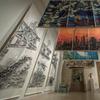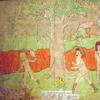NSU Art Museum Fort Lauderdale Announces New Acquisitions
- FORT LAUDERDALE, Florida
- /
- March 15, 2018
In celebration of its 60th anniversary, NSU Art Museum Fort Lauderdale announces that artworks by Theaster Gates, Jenny Holzer, Glenn Ligon, Zanele Muholi and Serge Vandercam have been acquired for its permanent collection. These new additions expand upon the museum’s strengths in contemporary art and European art of the post-World War II period, and will go on view to the public during 2018 and 2019 as part of a series of 60th anniversary exhibitions showcasing highlights of NSU Art Museum Fort Lauderdale’s 7,000-work collection.
The museum’s expansive early holdings in traditional African, Native and Oceanic art formed the core from which its collection developed. Today, NSU Art Museum Fort Lauderdale holds the largest U.S. collection of the post-World War II experimental Cobra group, an extensive collection of Latin American art and Modern and contemporary art with a focus on women and multicultural artists. The museum also houses the largest collection of the early American modernist William Glackens, a member of the socially progressive Ashcan School, who was instrumental in fostering modern art in America.
“NSU Art Museum Fort Lauderdale’s comprehensive collection has unique interlocking cultural and artistic narratives that have developed since its start in 1959,” said Bonnie Clearwater, NSU Art Museum Director and Chief Curator. “These acquisitions will generate new dialogue between current works in our collection as well as with museum visitors.”
New Acquisitions
Theaster Gates’ Reflection Piece, 2016, (clay, 13 x 10 x 11 inches) is a ceramic sculpture that combines a mask-life visage with a hollow vessel to form a reliquary of the human spirit. It combines references to African mask traditions and the American potter and former slave David Drake (aka Dave the Potter, c.1801- c.1870s). Its creation was a ritualistic practice related to Gates’ ongoing Dorchester Projects in which he has rehabilitated and reactivated abandoned and neglected buildings on Chicago’s South Side into lively cultural environments. Gates has used leftover wood and materials from the Dorchester restorations to create new works, and in this ceramic piece, Dorchester Projects wood was used to fire his kiln. The work was acquired through museum purchase.
Jenny Holzer’s The Survival Series: Remember to react, 1984 (cast aluminum, ed. 8/10, 3 x 10 in.) consists of a simple plaque with text that is both a commentary on contemporary life and call to social action. Holzer belongs to the influential group of artists known as the Pictures Generation who were part of the first generation of American artists that came of age in the 1960s and 1970s and who grew up inundated by television images and advertisements promoting post-World War II consumer culture. Works by Pictures Generation artists are one of the focal points of the museum’s contemporary holdings. This work was acquired through museum purchase.
Glenn Ligon’s, Untitled (I live on my shadow), 2009, (neon, glass, paint, ed. 3/5, 1 AP,5 3/8 x 56 ¼ x 1 ¾ in.) references abolitionist Sojourner Truth’s Carte de Visite, 1864. A former slave, Truth would sell photographs of herself to finance her livelihood as a traveling preacher and activist stating, ”I sell the shadow to support the substance.” The words in Ligon’s neon piece are eclipsed by the application of black paint on the front of the tubes of light. The process reverses the relationship between light and shadow as the neon illuminates the wall where a shadow would have been cast. The work was acquired through museum purchase.
Zanele Muholi’s striking black-and-white photograph, Thuleleni, Bijlmer, Amsterdam, 2017 (gelatin silver print, 27 x 22 in., ed. 3/8) addresses several traditions and contemporary art practices. South African-born Muholi self-identifies as a visual activist and advocate of the LGBT and intersex community and her photographs are bold images of empowerment. In this photograph, she darkened her subject’s skin to increase the contrast of her dark skin and background with the white in her eyes and paper ruffle. Although the composition and tonal effects suggest 17th century Dutch portraiture, the contrast between the dark skin and eyes of her subject give the face the appearance of an African mask. The title and style reference Holland, thereby evoking The Netherlands' complex colonial relationship with Africa. The work was acquired through museum purchase.
Serge Vandercam’s L’Echo, 1970 (gouache on paper, 43 ½ x 28 ½ in.) and Glancing Times (Les Temps des regards),1970, (oil on canvas, 51 x 38 1/4 in.) are the newest additions to NSU Art Museum’s renowned collection of Cobra art of the post-World War II period created by artists from Copenhagen, Brussels and Amsterdam. During a visit to Denmark’s Jutland Peninsula in 1962, Copenhagen-born Vandercam learned about Tollund Man, a mummified body from the 4th century BC, that was discovered with facial features intact. Vandercam was fascinated by the preserved body that had seemingly risen from the dead and based much of his subsequent work on it. The ghost-like figure in these two paintings emerges from the dark to stare at the viewer, showing as the artist noted “the mask of man, and at the same time reveal in the image of what man is like without the mask.” The work is a gift of Stéphane Janssen.
About NSU Art Museum Fort Lauderdale: Celebrating 60 Years
Celebrating its 60th anniversary in 2018, NSU Art Museum Fort Lauderdale provides exceptional learning and inspirational opportunities through access to works of the highest level of artistic expression. The Museum is housed in an 83,000-square foot modernist building designed by Edward Larrabee Barnes, and is located in the heart of the city’s downtown riverfront. Under the helm of Director and Chief Curator Bonnie Clearwater, the Museum is a leader in the visual arts and a vibrant cultural resource serving South Florida and national and international audiences. In 2008, the Art Museum became part of Nova Southeastern University, one of the largest private research universities in the United States. AutoNation, the country’s largest automotive retailer, presents a year of 60th anniversary programming.
A collecting institution since 1959, NSU Art Museum’s permanent collection was established with acquisitions of 19th and 20th Century American and European paintings and sculpture, Oceanic, African, Pre-Columbian and Native American art. Today, among its most notable holdings is the largest collection of Cobra art by the avant-garde post-World War II artists of Copenhagen, Brussels and Amsterdam in the U.S.; the world’s largest collection of works by American painter and Ashcan School founder William Glackens (1870-1938); strong collections of works by Latin American and Cuban artists of the 20th century; and contemporary paintings, sculpture, video, installations, and drawings with an emphasis on women and multicultural artists. Two scholarly research centers complement the collections: The Dr. Stanley and Pearl Goodman Latin American Art Study Center and the William J. Glackens Study Center.
Exhibitions and programs at NSU Art Museum Fort Lauderdale are made possible in part by a challenge grant from the David and Francie Horvitz Family Foundation. Funding is also provided by Wege Foundation, Nova Southeastern University, Hudson Family Foundation, Broward County Board of County Commissioners as recommended by the Broward Cultural Council and Greater Fort Lauderdale Convention & Visitors Bureau, the State of Florida, Department of State, Division of Cultural Affairs and the Florida Council on Arts and Culture. NSU Art Museum is accredited by the American Alliance of Museums.
Contact:
Dan SchwartzSusan Grant Lewin Associates
2129474557
dan@susangrantlewin.com






100x100_c.jpg)

![Peter Paul Rubens (Flemish, 1577–1640), After Titian (Tiziano Vecelli) (Italian [Venetian], c. 1488–1576), Rape of Europa, 1628–29. Oil on canvas, 71 7/8 x 79 3/8 in. Peter Paul Rubens (Flemish, 1577–1640), After Titian (Tiziano Vecelli) (Italian [Venetian], c. 1488–1576), Rape of Europa, 1628–29. Oil on canvas, 71 7/8 x 79 3/8 in.](/images/c/e2/2e/Jan20_Rape_of_Europa100x100_c.jpg)







